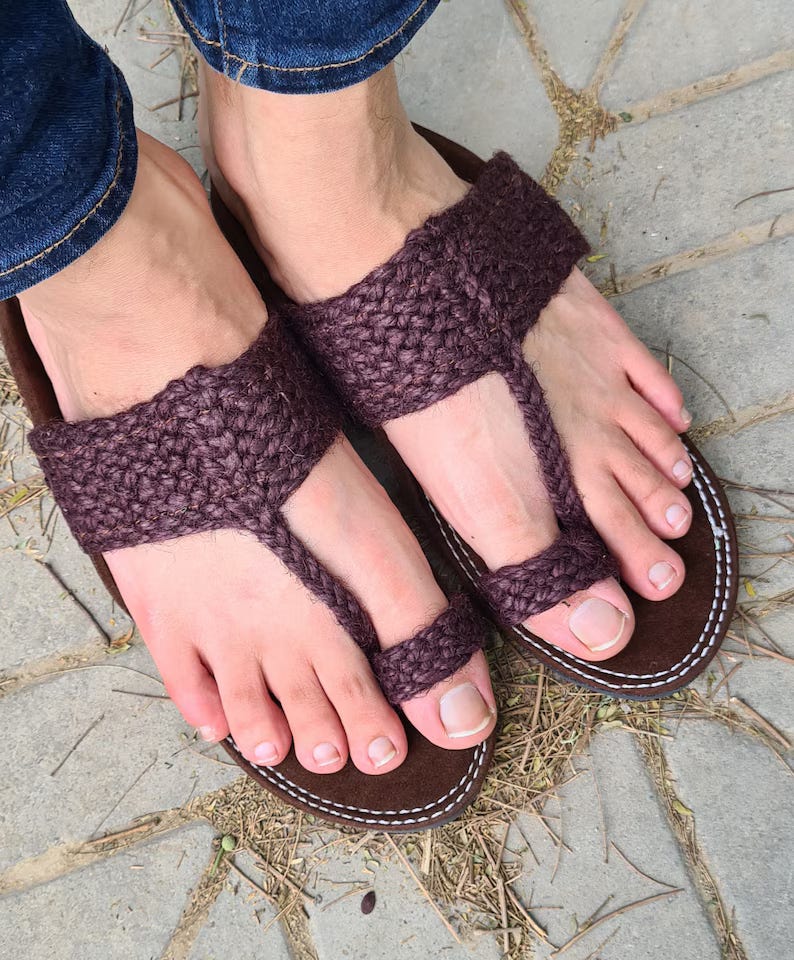Will Indian Artisans Benefit if Prada Starts Selling Kolhapuri-style Sandals
Indian officials acknowledge the value of artisans making Kolhapuri sandals but only after $16 billion Prada makes luxury copies
(Image: Leather toe ring sandals, Prada show, June 2025.)
June 28, 2025
Every decade or so an Indian clothing or accessory becomes fashionable in the West. In the 1960’s, hippies, students, and youth, in London, San Francisco, New York, and other major cities in Britain and the United States wore kurtas, following the example of the Beatles, notably George Harrison. In the 1980’s, the bold colors and patterns of India, particularly floral prints, were popular in the West, adopted by Britain’s Zandra Rhodes and other designers.
Now, the Indian media anticipates that hand-stitched leather sandals from Kolhapur, India, known as Kolhapuri chappals, will become popular among some Western consumers. The stories arose based on sandals worn by models at Prada's Spring/Summer 2026 menswear collection show in Milan, Italy, last week. While the Western fashion media calls them leather toe ring or open toe sandals, they were very expensive copies of Kolhapuris.
There is “growing criticism in India over…(Prada’s) use of the traditional design without acknowledging its roots,” stated The Hindustan Times. “We kindly urge Prada to acknowledge the inspiration behind the design publicly, explore possibilities for collaboration or fair compensation that could benefit the artisan communities involved,” an official of the Maharashtra Chamber of Commerce, Industry and Agriculture stated in a letter to Prada.
In the U.S., you can buy a pair of Kolhapuris, starting at $22, on Etsy, an online crafts retailer. Prada’s sandals sell for $850 or more.
Perhaps, Prada may not have wanted to disclose the origins of its Kolhapuris in order to try to prevent other Western luxury footwear brands from selling competing versions and that too at a lower price. After all, even the artisan cobblers in the states of Maharashtra and Karnataka, who stitch the Kolhapuris, have no copyright or other legal protections over their designs and shapes.
(Image: Kolhapuri Sandals, for sale on Etsy.)
Prada is part of the Prada Group whose other brands include Miu Miu, Church's, Car Shoe, and Marchesi. The group designs and produces ready-to-wear, leather goods, footwear, and jewelry collections. It owns 26 factories and has more than 15,200 employees worldwide. The luxury goods are sold in more than 70 countries, through 609 company owned stores and e-commerce channels, and online retailers, and department stores. The group also licenses its name for eyewear and beauty products.
In 2024, the group’s revenues totaled $6.3 billion. Listed on the Hong Kong stock exchange, the company has a market value of $16 billion. Four fifths of the stock is owned by the two key executives and their families. Miuccia Prada Bianchi, age 76, is Co-Creati0ve Director of the Prada Group. Patrizio Bertelli, 79, is the Executive Chairman. A married couple, they each have a net worth of $5.1 billion, according to Forbes
Prada was founded in 1913 by Miuccia Prada’s grandfather. “Thorough observation and curiosity for the world around us have always been at the heart of the creativity and modernity of the Prada Group,” according to a mission statement from Prada and Bertelli posted on the company’s site. “By being DRIVERS of CHANGE, we offer an unconventional dialogue and interpretation of the contemporary, as expression of our way of doing business for PLANET, PEOPLE and CULTURE.”
Even some fashion media in the West, who depend on advertising from major fashion houses, raised questions about Prada’s Kohlapuri copies. Women’s Wear Daily, published from New York, noted, “without any public-facing reference to the artisans or origins, it’s easy to see why some felt the moment lacked context.”
The Prada management sought to dampen the growing criticism in India and elsewhere. “We acknowledge that the sandals featured in the recent Prada Men's 2026 Fashion Show are inspired by traditional Indian handcrafted footwear, with a centuries-old heritage. We deeply recognize the cultural significance of such Indian craftsmanship,” Lorenzo Bertelli, Prada Group Head of Corporate Social Responsibility, reportedly stated in a reply to the Maharashtra Chamber of Commerce.
Lorenzo added that the Prada toe ring sandals are at an early stage of design development and none of the pieces may be commercialized. “We are committed to …opening a dialogue for a meaningful exchange with local Indian artisan communities.”
Next year, if Prada starts selling its Kohlapuri style sandals, will buyers in the West pay around $850 for a pair? Very few Indians can afford to pay such prices. In India, a pair of Kolhapuri sandals sell for around $9 on Walmart’s Flipkart online store. More important, if there is any compensation paid to Indian groups by Prada, will the artisans in India receive most of the payments?
Dileep More, a local businessman in Kolhapur told Reuters that the artisans "are happy that someone is recognising their work." Laila Tyabji, a designer who has worked with artisans, told the Press Trust of India, that Prada’s appropriation of the Kolhapuris, “is a metaphor for how we in India often undervalue our own heritage, dismissing it as primitive or merely ‘handicraft,’ while the world repackages it as luxury.”



